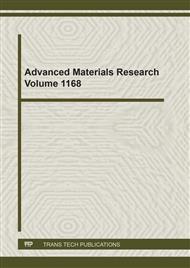[1]
Yunus Ali Hamdani, Use of Areca Palm (Betel Nut) Fibers as Enhancement in Conventional Concrete,, MSc Dissertation, Department of Structural and Construction Engineering, University of Dar es Salaam, (2020).
Google Scholar
[2]
Reddy, N.; Yang, Y. Properties of natural cellulose fibers from hop stems. Carbohyd. Polym. 2009, 77, 898-902. Journal of Minerals and Materials Characterization and Engineering, (2009).
DOI: 10.1016/j.carbpol.2009.03.013
Google Scholar
[3]
Domke, P. V., (2012). Improvement in the strength of concrete by using industrial and agricultural waste. IOSR Journal of Engineering, Vol. 2(4), p.755 – 759.
DOI: 10.9790/3021-0204755759
Google Scholar
[4]
Kishore Dinakaran, Harish Ramesh, Allan Dojo Joseph, Dr Ramu Muguran and Dr Sathishkumar Jothi, Development and Characterization of areca fiber reinforced polymer composite,, Materials Today: Proceedings 18(2019) 934-940, Elsevier, Available online at www.sciencedirect.com.
DOI: 10.1016/j.matpr.2019.06.528
Google Scholar
[5]
Panthaulakkal S, and M. Sain,Agro-residue Reinforced High Density Polyethylene Composites; Fiber Characterization and Analysis of Composite Properties,, Composites Part A; Applied Science and Manufacturing, 38 (6) 1445-1454, (2007).
DOI: 10.1016/j.compositesa.2007.01.015
Google Scholar
[6]
Reis, J.M., (2005). Fracture and flexural characterization of natural fibre reinforced polymer concrete. Construction and Building Materials, Vol. 20, p.673 – 678.
DOI: 10.1016/j.conbuildmat.2005.02.008
Google Scholar
[7]
Jawaid M, AA Al Masri, HPSA Khalil, Cell Wall Morphology, Chemical and Thermal Analysis of Cultivated Pineapples Leaf Fibers for Industrial Applications,, Journal of Polymers and Environment, 2012, Springer Science + Business Media, 20: 404-411; DOI 10.1007/s10924-011-0380-7.
DOI: 10.1007/s10924-011-0380-7
Google Scholar
[8]
Nadir Ayrilmis, Fueangvivat, V. and Songkold, J., (2011). Coir Fibre Reinforced Polypropylene Composite Panel for Automotive Interior Applications. Fibers and Polymer Vol. 12, p.919 – 926.
DOI: 10.1007/s12221-011-0919-1
Google Scholar
[9]
Mohammed, D., Kazuhiro, M., Masayuki, Y., and Satoru, T., (2007). Processing and mechanical property evaluation of maize fiber reinforced green composites. Advanced Composite Materials, Vo1. 6(4), pp.335-347.
DOI: 10.1163/156855107782325168
Google Scholar
[10]
Chouw, N. and Majid, A., (2012). Experimental investigations on coconut – fibre rope tensile strength and pullout from coconut fibre reinforced concrete. Construction and Building Materials, Vol. 41, p.681 – 690.
DOI: 10.1016/j.conbuildmat.2012.12.052
Google Scholar
[11]
Liu A., Chouw, N., and Majid, A., (2011). Mechanical and dynamic properties of coconut fibre reinforced concrete. Construction and Building Materials, Vol. 30, p.814 – 825.
DOI: 10.1016/j.conbuildmat.2011.12.068
Google Scholar
[12]
Surappa S, K Chandra Shekar, Shiva Kumar and M Radhika, Tensile Behaviour of Jute and Bamboo Fiber Reinforced Polymer Matrix Hybrid Composites, Materials Science and Engineering, IOP Conference Series: 1057 (2021) 012014 IOP Publishing.
DOI: 10.1088/1757-899X/1057/1/012014
Google Scholar
[13]
Hassan, M. M., Khan, M. A., Wagner, M. H. and Zaman, H. U., (2011). Study on the performance of hybrid jute/betel nut fibre reinforced polypropylene composites. Journal of Adhesion Science and Technology, Vol. 25(6 – 7), p.615 – 626.
DOI: 10.1163/016942410x525858
Google Scholar
[14]
Biswas, S. and Subhankar, (2015). Physical, mechanical and thermal properties of jute and bamboo fiber reinforced unidirectional epoxy composites. International Conference on Thermal Engineering.
DOI: 10.1016/j.proeng.2015.05.118
Google Scholar
[15]
Lazim, Y., Muhammad, J. and Mustapha, M., (2014). Effect of alkali treatment on the physical, mechanical and morphological properties of waste betel nut husk fibre.
DOI: 10.15376/biores.9.4.7721-7736
Google Scholar
[16]
Bakri, K. B., Hamdanb, S., Jayamania, E., and Rahman, M. R., (2014). Investigation of fiber surface treatment on mechanical, acoustical and thermal properties of betel nut fiber polyester composites. Procedia Engineering Vol. 97, p.545–554.
DOI: 10.1016/j.proeng.2014.12.282
Google Scholar
[17]
ASTM D638 -14: Standard Test Method for Tensile Properties of Plastics.
Google Scholar
[18]
BS EN 197-1:2000, Cement Part 1: Composition, specifications and conformity criteria for common cements.
Google Scholar
[19]
BS 812 – 2: Testing Aggregates; Methods for determination of density.
Google Scholar
[20]
BS 5328-1-1997: Guide to Specifying Concrete, BSI, London.
Google Scholar
[21]
BS 5328-2-1997: Methods for Specifying Concrete Mixes, BSI London.
Google Scholar
[22]
Anil Kumar, Anoop Kishan K., and Divakar L. Sudheer, Study on Compressive Strength of Concrete Using Areca Fibers as Reinforcement,, International Journal of Engineering Trends and Technology (IJETT), Volume 24, Number 3, June (2015).
DOI: 10.14445/22315381/ijett-v24p222
Google Scholar


